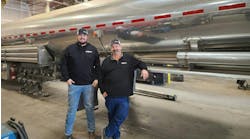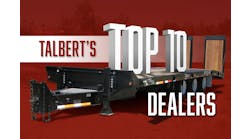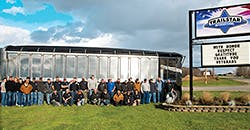TRAILSTAR, trailers can be seen frequently operating on roads and highways, especially in the Midwest. They are primarily used for farming, roadwork and construction. They can also be found on display at major trucking shows.
While not as commonplace as Wabash or Great Dane, the Trailstar brand shows up frequently enough to lead people to expect them to be the product of a mid-sized trailer plant. But they aren’t.
“We are in a little 10,000-sq-ft plant,” says Tom Hahn, president. “A lot of customers, vendors and dealers say, ‘You produce all of your trailers in this little building?’ And they’re just amazed at what you can do with a good group of guys. It all ties back to the quality of what the guys do out there and the effort they put in. They’re a team, with every member in one 10,000-sq-ft room.
“The building may be small, but we are currently building six trailers per week and—depending on the type of trailer—can produce as many as 10.
“Over the course of our history, our company has built almost every type of trailer except vans and tanks. But we are concentrating now on aluminum dump trailers—both frameless and frame type—and dump bodies. We could build a greater variety than we are right now. The demand is there for these types of trailers, but the capacity for us to build them isn’t. For example, we have some steel trailers in our repertoire that we have offered in the past, but broadening our product offering at this point would cut into our efficiency.”
Much of that efficiency comes from doing things once, without having to do them over. And much of that comes from the size of the facility.
“When I walk through our plant, I can see from one end to the other. I can usually see if something is crooked, if something is installed wrong or a weld looks bad,” Hahn says. “I can tell, and it’s important to train employees to know it, too.”
Hahn is convinced that training goes beyond teaching people to weld—or even how to assemble trailers.
“A lot of employers say that too many job applicants don’t have the desire to work. Our goal is to instill in everyone here a desire for quality—and it isn’t quite as difficult as that might seem. People want to climb with the company. To do so, they need to be able to grow and to understand what they’re doing. Why does this gusset go here? Why are the suspension measurements important? What do we need to do so that the trailer we are building will go smoothly through the line?
Because of the size of the plant and the variation in the types of trailers produced, Trailstar employees perform multiple tasks on trailers with fluctuating specifications.
“We have to teach our employees why details matter,” Hahn says. “We’ll cross-train a lot of our employees as they go through from one department to another department so they understand how the trailer works. Getting to this point doesn’t happen overnight. It takes time and hard work. We let them know that we’re all human; we’re going to make mistakes. The key is to fix it now. It is more cost effective to inspect your work and repair any issues during the manufacturing process then it will be after the trailer is shipped off of our lot to our customer and then the issue is detected.
Miniature assembly line
Trailstar produces trailers on what Hahn calls a miniature assembly line.
“We have our fab department that produces all of our material,” Hahn says. “It steps down to the next stations where one team builds the floor upside down on one table and another team builds the sides on another table.”From there, these subassemblies are brought together at what Trailstar calls the body station. All subassemblies are moved by crane.
On the other side of the building is the chassis department where Trailstar builds subframes, the draft arms, and frames made of either aluminum or steel.
“One thing we always do is to check the twist on all of our bodies and chassis,” Hahn says. “They have to be plus or minus an eighth of an inch. If you’re starting out with twisted assemblies, the finished product will not be right.”
Assembled trailers then move to the mounting and plumbing section where assemblers install the pneumatics, the hydraulics, and electrical lines.
“Last stop is the detail shop. That’s where we apply the stickers and they make sure everything is right. We have a 150-point inspection list where they go through and test everything, check everything.”
Special relationships
Trailstar strives to develop special relationships, not only with customers, but also with suppliers.
“I get calls on Saturday or Sundays sometimes from my customers saying, ‘Hey, is there any chance I can get picked up? I’ve got a problem.’ ‘Sure, I’ll meet you over at the shop.’”
As a customer of suppliers and vendors, Hahn strives to maintain strong relationships with them. He also expects them to have the same philosophy regarding customer service.
“I can handle my guys out here in the shop. I don’t have that level of control with my vendors. So when I have a vendor that has the same philosophy, I value that. They’ll be there for me. It’s great to be able to pick up the phone and say, ‘hey, I’ve got a problem.’”
Hahn cites suppliers such as Truck-Lite and Hendrickson. Both are companies with whom Trailstar has enjoyed long relationships. ESAB, Trailstar’s welding equipment vendor, works the same way.
“They come to us to help them with projects they are involved in and will even ask that we test a product from time to time. We’ll try it out and determine where the bugs are and help figure out a solution,” Hahn says.
A small plant has no room for equipment downtime. Trailstar has a full-time maintenance supervisor charged with keeping the equipment humming.
“I want to be able to work on equipment and not wait five weeks for a product to get replaced,” Hahn says. “That was a big reason why we equipped our plant with Warrior welders. My plant manager told me, ‘If something goes wrong, we pull out this circuit board, put a new one in, and go back to welding.’”
As is the case with many types of trailers, welding is a key component.
“We run between 230 and 300 amps,” says Mike Schmidt, shop supervisor at Trailstar. “Many of our welds are 10 feet long, and some of the verticals can be 80 inches long. We try to weld continuously, so we have equipped the plant so that we can weld 10 feet before we run out of cable.”
Wire and wire feeders also play a key role.
“We use a push gun,” Schmidt says. “I think there is a misconception that you have to have a push-pull gun, but that hasn’t been our experience. We do think that the type of wire is important. We are using 1/16-inch Alco Tec NT wire for 3/16-inch parts so that we don’t have to change wire all the time. Otherwise, we would be changing wire 10 times a day. We can use it on different thickness—we just adjust the amperage.”
The bulk storage system keeps the work going.
“Our average weld is about eight feet long,” Schmidt says. “If you want to know what heat is, come here when it’s 100 degrees outside and we are running a 40-ft weld nonstop. Our welding equipment makes it possible for us to weld as long as we can hold the torch.”
Or unless the gun jams.
“Smooth wire feeding is essential,” Schmidt says, “and it has to be clear of aluminum shavings to prevent build-up in the gun.”
Trailstar now has between 22 and 25 welders working two shifts.
“We have to train them,” Schmidt says. “Tech schools are not teaching people how to MIG weld aluminum.”
Good times, bad times
Hahn has been with Trailstar since 1983, three years after the company was formed. He started near the bottom and worked his way up.
“I was a grunt laborer who unloaded trucks by hand and cleaned up the shop,” he recalls. “But we had a great atmosphere. When I started here in 1983, I was trained that it takes a team to do everything you do and that we put pride in what we do. I was proud of the work we did, and I saw a future for myself here at Trailstar.”
That future came to a screeching halt in the aftermath of the Great Recession. After working at the company for almost 30 years, Trailstar closed its doors.
“Things started getting bad back in 2008 and 2009, but it wasn’t until 2011 that we really experienced the fall-out. It went from good times to hard times all the way down to no times. In 2012 Trailstar Manufacturing went out of business. It was tough. I couldn’t imagine myself doing anything different or working anywhere else. My heart was in this company. To me, it was like a marriage.”
Not wanting the “marriage” to end, Hahn found a financial backer and bought Trailstar out of bankruptcy.
“I didn’t do it just for myself,” Hahn says. “A lot of people depended on it, both on the customer side and the people that work here. And so in 2013 we bought the property, the equipment, the name and started up Trailstar International.”
Keeping it breathing
Almost a full year went by between the time Trailstar Manufacturing closed its doors and when the new financing enabled Trailstar to begin building trailers at its facility once again.
“At the end of 2011, we were just getting by—piecing things together, doing whatever we could to keep things going,” Hahn says. “I was able to retain about 15 employees who were working at Trailstar at the time of the bankruptcy. Late in 2012, as the bankruptcy made its way through the courts, we began building a few trailers. We added others—former employees who wanted to come back, along with some new ones.”
So how do you breathe new life into a company after all that it went through?
“A lot of effort and elbow grease,” Hahn says. “We rented a facility and worked on small jobs, service jobs, and building an occasional new trailer. Under the conditions that we had during that time, it took 30-45 days to build a new trailer. We had a small crew, service work that we were doing on the side, and only a one-bay garage.
”We knew that we eventually would get back to our old location—it was just a matter of convincing the guys. Their hearts were in it, so they would do anything it took together as a team. It kind of reminded me of the old days when Trailstar first started, putting long hours in and reaching out to customers.
“As we started back up, there were some customers that weren’t happy. We had to win them back and earn their respect again. They had to know that we’re going to be here to support the product. I was willing to take it on the chin when I had to.”
And now better times
Although Trailstar knows how to get good production from a small plant, Hahn also knows that even more trailers can be built with a larger facility.
“I’m currently working on designs for a 60,000 square foot building on our adjacent property. When we do, we’ll probably be getting back up to 100 employees,” Hahn says.
The company is capable of far more than its current production.
“There are a lot of trailers out there on the market, and we have a minimal share of it right now,” Hahn says. “We are currently building six trailers a week. We started out back in 2013 building two a month. We’ve overcome the vast problem of the old Trailstar financial problems. I think we’ve earned back the respect of a numerous vendors, customers and competitors. We also are working to rebuild our dealer network.
“We have a dealer network of about 27 dealers across the country, always looking for good dealers, people that want a partnership, not just paperwork.”
Partners and teamwork. They are an effective way of to get big results, regardless of the size of the building. ♦
















